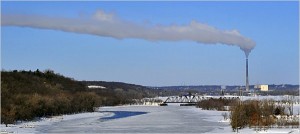 On a blog whose theme is comparing the past with the present, I found (thanks to Tyler Cowen) a post that asks: “Why are the east of cities usually poorer?”
On a blog whose theme is comparing the past with the present, I found (thanks to Tyler Cowen) a post that asks: “Why are the east of cities usually poorer?”
The main reason, it seems, is that in most of the northern hemisphere, winds blow from west to east. So in the days of heavy industrial pollution from the smoke stack industries, the air was cleaner on the west side of town. Living in the east-end was less desirable and less expensive.
Before the industrial revolution, smoke from private chimneys – used much more than today since that’s how people kept warm – also blew from west to east.
Another factor may have been the direction in which the local river flowed. Rivers carried sewage, and if the river flowed west to east, as it does in London, that’s another reason the east-end was less desirable.
This has obvious implications for the inequitable distribution of health and longevity among economic classes, although it’s only one of many factors.
Coming Up
On principle I don’t make New Year’s resolutions, but I’m considering a series of posts for the new year. Can’t be sure they’ll materialize until I start to write them.
- A history of the physical exam and its role in diagnosis
- A history of the doctor/patient relationship
- How the physical exam and doctor/patient relationship relate to patient modesty
- The three eras of medical history (traditional, modern, post-modern)
- The transition from traditional to modern medicine
- The brief “patient-as-person” period in the era of modern medicine
- What happened in the Golden Age of medicine
- Why the Golden Age of medicine ended and what followed
- How psychiatry was affected by the transition to post-modern medicine
- Doctors on TV in the modern and post-modern eras
- The three eras of medicine as seen by medical sociologists
- The transition from the human-centered ideas of the Enlightenment, with the ideal of perfecting society, to a predominant emphasis on biological life, with the goals of individual perfectibility, enhancement, and life extension
- The nature of medicine today, as captured by the recent book Against Health
.
This will take me a while. In the meantime, Happy New Year!
Related posts:
Income inequality and American politics
Life expectancy of the rich and the poor
The end of the American dream?
Health inequities: An inhumane history
Resources:
Image: New York Times
Dan Zambonini, Why are the East of Cities usually Poorer?, Januarist, May 31, 2010
Jonathan Metzl and Anna Kirkland, editors, Against Health: How Health Became the New Morality


Sorry, comments are closed for this post.